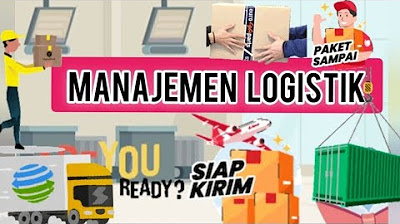Conceptual Framework of Logistic
Summary
TLDRThis video explores the fundamentals of logistics management, covering procurement, storage, distribution, and customer service. It highlights the importance of reducing costs while maintaining superior service, providing a competitive advantage. The evolution of logistics systems, from basic distribution to integrated value chains, is discussed, emphasizing efficiency in the global market. Key players in the logistics industry, such as multinational and national companies, are identified. The video also explains the significance of logistics integration, focusing on seamless order processing, inventory management, and transportation coordination to enhance supply chain performance.
Takeaways
- 😀 Logistics activities include procurement, storage, and delivery, with customer service being a key performance indicator.
- 😀 Logistics aims to improve efficiency and productivity, reduce costs, and provide better service, which leads to competitive advantage.
- 😀 In the globalized world, multinational companies are expanding supply chains, with innovation being a crucial factor in choosing logistics providers.
- 😀 Triple-A logistics companies provide services in areas like warehousing, distribution, and document management, controlling significant portions of the logistics market.
- 😀 The logistics industry in China is a dominant force in Asia, with substantial global market influence, particularly in North America and Europe.
- 😀 Indonesia's logistics costs are estimated at 15-20% of GDP, indicating inefficiency compared to other countries like Korea and Japan.
- 😀 Business trends in logistics have evolved, from mass production to cost-efficient product development, quality service, and customer relationships in the 90s, to a focus on supply chain management in the 2000s.
- 😀 International logistics players include companies like TNT and UPS, while Indonesia has both multinational and national logistics providers such as Posindo.
- 😀 The logistics system has evolved from a partial distribution model to an integrated system, adding value at each stage from supplier to customer.
- 😀 The logistics cycle involves a continuous flow of orders from customers, through manufacturers and distributors, with integrated information sharing to streamline the entire process.
Q & A
What are the main activities involved in logistics management according to the script?
-The main activities in logistics management include procurement, storage, delivery (which consists of transportation and customer service).
What is considered the performance indicator of logistics activities?
-The performance indicator for logistics activities is customer service, where the customer receives services, the provider receives costs, and the owner gains profits.
What is meant by the competitive advantage in logistics?
-Competitive advantage in logistics refers to reducing costs while providing better service, which allows companies to be more efficient and productive in a globalized market.
What role does innovation play in the logistics industry?
-Innovation in logistics plays a critical role in the supply chain, as it influences how logistics companies can serve consumers' needs and streamline operations.
What is the significance of China in the logistics industry, particularly in Asia?
-China is a dominant force in the logistics industry in Asia, significantly influencing global supply chain activities and logistics services.
How do logistics costs in Indonesia compare to other countries like Korea and Japan?
-In Indonesia, logistics costs account for 15-20% of GDP, which is higher compared to Korea and Japan, where logistics costs are relatively lower.
What are the key stages of the evolution of logistics systems?
-Logistics systems evolved from being partial (focused on physical distribution) to integrated, and now to value chain logistics, which adds value through the entire process from supplier to customer.
How do logistics processes integrate from suppliers to customers?
-In integrated logistics, the process is continuous and seamless, where information flows between suppliers, manufacturers, distributors, and customers, ensuring an uninterrupted supply chain.
What is the customer order cycle in logistics, and why is it important?
-The customer order cycle refers to the process starting when a customer places an order, followed by order processing, manufacturing, and delivery. This cycle ensures timely delivery and inventory management, integral to customer satisfaction.
What are the roles of suppliers in the logistics process?
-Suppliers provide raw materials or components based on orders received from manufacturers. They play a crucial role in ensuring that the right products are available to manufacturers for production.
Outlines

This section is available to paid users only. Please upgrade to access this part.
Upgrade NowMindmap

This section is available to paid users only. Please upgrade to access this part.
Upgrade NowKeywords

This section is available to paid users only. Please upgrade to access this part.
Upgrade NowHighlights

This section is available to paid users only. Please upgrade to access this part.
Upgrade NowTranscripts

This section is available to paid users only. Please upgrade to access this part.
Upgrade Now5.0 / 5 (0 votes)





